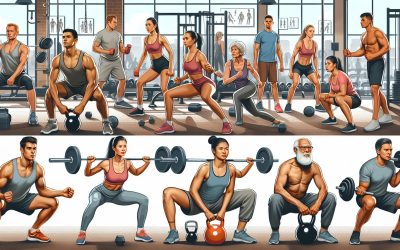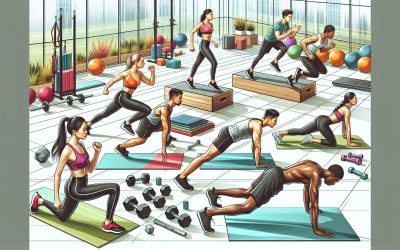In the world of fitness, where time is as precious as the results, High-Intensity Interval Training (HIIT) has emerged as a game-changer. It’s all about pushing your limits, but not your patience, by alternating between intense bursts of activity and fixed periods of less-intense activity or even complete rest.
HIIT isn’t just a workout trend; it’s a scientifically backed approach to getting fit faster. Whether you’re a seasoned athlete or someone just starting their fitness journey, HIIT promises to maximize efficiency and results, making every second of your workout count. So, if you’re ready to turbocharge your fitness routine, dive into the dynamic world of HIIT and see how it can transform not just your workouts, but your entire approach to fitness.
The Science Behind High-Intensity Interval Training
High-Intensity Interval Training (HIIT) isn’t just a trend that’s caught the fitness world by storm; it’s supported by solid scientific research that underscores its effectiveness. This workout methodology intersperses short bursts of intense exercise with periods of rest or low-intensity exercise. But what makes it tick? Let’s delve into the science that makes HIIT not just a workout, but a smart workout.
At the heart of HIIT’s effectiveness is its ability to boost metabolic rate. Studies have shown that engaging in HIIT can elevate an individual’s resting metabolic rate for up to 48 hours after a workout. This phenomenon is known as the afterburn effect or Excess Post-exercise Oxygen Consumption (EPOC). Simply put, one’s body continues to burn calories long after the workout has ended, a feat not as pronounced in traditional endurance training.
Another cornerstone of HIIT’s effectiveness is its impact on cardiovascular health. Research indicates that participants who engage in regular HIIT sessions witness significant improvements in their heart health, including reduced blood pressure and improved cholesterol levels. Moreover, HIIT has been shown to enhance aerobic and anaerobic fitness, with participants experiencing improvements in their VO2 max, a marker of endurance that measures the maximum amount of oxygen one can utilize during intense exercise.
But what about muscle? Here, too, HIIT shows promising results. The high-intensity nature of the workout not only helps in shedding fat but also in building lean muscle mass—especially when exercises target multiple muscle groups. This is particularly beneficial for those looking to improve their body composition without spending hours in the gym.
Interestingly, HIIT’s benefits extend beyond the physical. Recent studies suggest that high-intensity workouts can also have positive effects on mental health. Participants report improvements in mood, reductions in stress levels, and even a decrease in symptoms of depression and anxiety. This could be attributed to the release of endorphins, or “feel-good” hormones, during and after intense exercise.
For those worried about the time commitment, there’s good news. Research supports the notion that HIIT can provide these significant health benefits in sessions much shorter than traditional workouts. For instance, a study comparing the effects of 30 minutes of HIIT to an hour of cycling found comparable improvements in cardiovascular health and muscle gain, making HIIT an ideal choice for those with busy schedules.
Benefits of High-Intensity Interval Training
High-Intensity Interval Training (HIIT) stands out not just for its efficiency, but also for the myriad of health benefits it offers. Unlike traditional endurance training, HIIT packs a powerful punch in both physical and mental health arenas, providing a comprehensive workout solution.
Boosted Metabolic Rate
One of the top benefits of HIIT is the significant boost it gives to metabolic rates. This afterburn effect, scientifically known as excess post-exercise oxygen consumption (EPOC), means your body continues to burn calories at an elevated rate long after your workout has finished. Research has consistently shown that individuals who engage in HIIT can burn more fat and calories in the 24 hours following their workout compared to those sticking with steady-state cardio exercises.
Improved Cardiovascular Health
HIIT is also incredibly beneficial for heart health. This training method alternates between high-intensity bursts and periods of rest or low-intensity exercise, pushing the heart to adapt to varying levels of stress. Over time, this leads to improved cardiovascular fitness, with studies indicating that regular HIIT sessions can significantly lower blood pressure and heart rate in overweight and obese individuals. This makes HIIT an effective strategy for reducing the risk of heart diseases.
Enhanced Muscular and Aerobic Capacity
The dynamic structure of HIIT challenges both the aerobic and anaerobic systems. It’s not only about improving endurance; HIIT sessions contribute to enhanced muscular strength and power. The quick and intense nature of HIIT exercises means that muscles are being worked to their limits, promoting growth and endurance. Consequently, individuals can experience improvements in their aerobic capacity, allowing them to perform activities for longer periods without fatigue.
Mental Health and Mood Improvement
The benefits of HIIT transcend physical health, extending into mental well-being. Engaging in this form of exercise has been linked to reduced stress levels, anxiety, and depression. The endorphins released during intense exercises contribute to a feeling of euphoria often referred to as the “runner’s high,” but HIIT can achieve this in a fraction of the time. Moreover, the sense of accomplishment after completing a challenging HIIT session can boost self-esteem and mood, contributing to overall mental health.
Designing an Effective HIIT Workout Plan
Creating an effective HIIT workout plan involves understanding the balance between high-intensity intervals and recovery periods. To maximize efficiency and results, one must tailor their HIIT sessions to fit their fitness level and goals.
Understanding the Basics
The foundation of a HIIT workout lies in alternating periods of intense exercise with less intense recovery periods. This approach capitalizes on the body’s ability to improve both aerobic and anaerobic systems significantly. An ideal ratio for beginners might be a 1:2 ratio of exercise to recovery, gradually shifting to a 1:1 ratio as fitness improves.
Key Components of a HIIT Session
- Warm-Up: Essential for preparing the body and preventing injury, a 5-10 minute warm-up of light aerobic exercises and dynamic stretching is crucial.
- High-Intensity Intervals: These should push you out of your comfort zone. Options include sprinting, jumping jacks, or burpees, lasting from 20 to 90 seconds.
- Recovery Periods: Active recovery, like walking or light jogging, helps lower the heart rate and prepares the body for the next high-intensity burst.
- Cool Down: A 5-10 minute period to return the heart rate to normal with static stretching to aid in recovery and flexibility.
Planning Your HIIT Workouts
Varying the exercises, intervals, and total workout time can help prevent plateaus and maintain progress. For beginners, starting with shorter sessions, around 20 minutes, and gradually increasing the duration to 30 minutes or more is a smart strategy.
| Aspect | Beginner | Intermediate | Advanced |
|---|---|---|---|
| Total Duration | 20 minutes | 30 minutes | 30-40 minutes |
| High-Intensity Length | 20 seconds | 30 seconds | 30-90 seconds |
| Recovery Length | 40 seconds | 30 seconds | 30 seconds |
| Frequency | 2-3 times per week | 3-4 times per week | 4-5 times per week |
- Rotate through a wide range of exercises targeting different muscle groups.
- Experiment with different forms of HIIT like Tabata, circuit training, or AMRAP (As Many Rounds As Possible).
- Adjust intensity
Tips for Maximizing Results with HIIT
To see significant gains from High-Intensity Interval Training (HIIT), there are several strategies individuals can employ. It’s not just about how hard they push themselves during the high-intensity intervals but also how they support their recovery and overall fitness regimen.
Firstly, hydration and nutrition play pivotal roles in one’s success with HIIT. Proper hydration before, during, and after workouts helps maintain peak performance and aids in recovery. Incorporating a balanced diet rich in proteins, healthy fats, and carbohydrates can provide the energy needed for the workouts and support muscle repair and growth.
Consistent practice is another cornerstone of maximizing HIIT results. It’s tempting to dive into daily HIIT sessions hoping for quicker results. However, this can lead to burnout and injury, defeating its purpose. Most experts recommend incorporating HIIT into your routine 2-3 times a week, allowing your body ample time to recover.
Here’s a basic guideline for how often to incorporate HIIT based on fitness levels:
| Fitness Level | HIIT Sessions per Week |
|---|---|
| Beginner | 1-2 |
| Intermediate | 2-3 |
| Advanced | 3-4 |
Integrating strength training into your routine on non-HIIT days can also enhance your performance and results. Strength training builds the muscle necessary to power through those intense bursts of activity and improves overall fitness, making the body more efficient during both high and low-intensity work.
Another tip often overlooked is tracking your progress. Monitoring the improvements, not just in terms of weight or physical appearance but also in performance, can be incredibly motivating. Whether it’s the ability to perform a high-intensity interval for longer, reducing recovery times, or lifting heavier weights, recognizing these improvements can push you to keep going.
Listening to your body is paramount. While pushing limits is part of HIIT’s appeal, there’s a fine line between pushing oneself and risking injury. Rest days are just as important as the days you train. They allow your body to repair and grow stronger. If something feels off, take the time to rest or consider seeking professional advice.
Incorporating HIIT into Your Fitness Routine
Integrating High-Intensity Interval Training (HIIT) into one’s fitness routine should be approached with both excitement and strategy. For beginners, starting slow is key to building endurance and minimizing the risk of injury. Initially, adding one to two HIIT sessions per week is advisable, allowing for adequate recovery time between workouts. As one’s fitness level improves, they can consider increasing the frequency to three times a week, ensuring a day of rest or low-intensity activity in between sessions.
A well-structured fitness routine pairs HIIT with strength training exercises to create a balanced approach. On days when HIIT is not on the agenda, engaging in resistance training can help in building muscle mass and further boosting metabolism. Alternating between these types of workouts not only prevents boredom but also ensures that different muscle groups are being engaged and conditioned over time.
Hydration and Nutrition
To maximize the benefits of HIIT, paying close attention to hydration and nutrition is non-negotiable. Given the intensity of these workouts, replenishing fluids is crucial to prevent dehydration, which can significantly hinder performance and recovery.
- Before a workout, it’s important to be well-hydrated and to have consumed a light meal or snack that includes carbohydrates and protein. This can help in providing the energy needed for the session.
- During the workout, sipping on water as required will help in maintaining hydration levels.
- After the workout, rehydrating and consuming a meal rich in protein can aid in recovery and muscle repair.
Monitoring Progress and Listening to Your Body
Keeping track of progress through a fitness journal or an app can be incredibly motivating. Recording how one feels during and after sessions, the weights lifted, and the type of HIIT workouts completed, provides valuable insights into performance improvements and areas needing more focus.
More importantly, listening to one’s body is crucial. HIIT, by nature, is demanding, but it shouldn’t cause pain or injuries. If a workout feels overly strenuous or if fatigue sets in, it’s essential to allow the body time to recover. Remember, rest days are as important as workout days.
Conclusion
Embracing High-Intensity Interval Training can revolutionize one’s fitness journey, offering a pathway to achieving goals efficiently. By starting slow, pairing HIIT with strength training, and focusing on hydration and nutrition, individuals set themselves up for success. It’s essential to listen to one’s body and monitor progress to adapt and grow stronger. With these strategies, anyone can maximize the benefits of HIIT, making every sweat session count towards a healthier, more vibrant self.
Elizabeth Redd: I am a passionate advocate for Health and Healing, dedicated to empowering individuals to live their best lives.
As the founder and publisher of Health and Healing, I have established myself as a guiding force in the wellness industry.
I am committed to providing the latest research, holistic approaches, and inspiring stories to open new possibilities for your health and healing journey.
Learn more about Elizabeth and Join Us at Health and Healing. Also, check out My About Page.





0 Comments